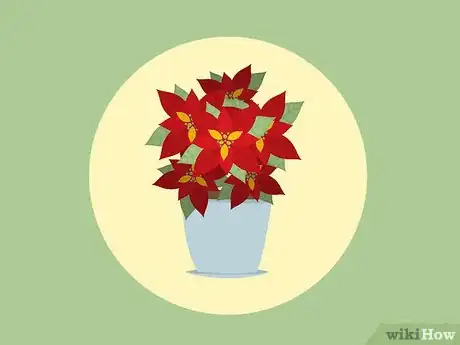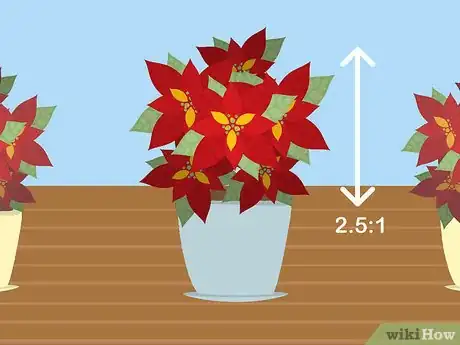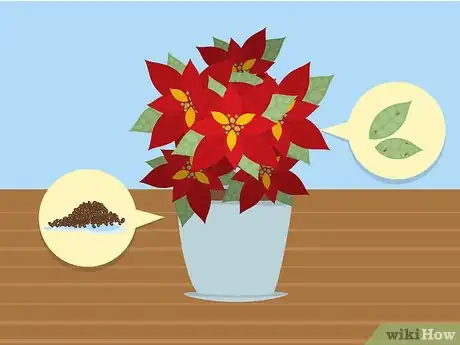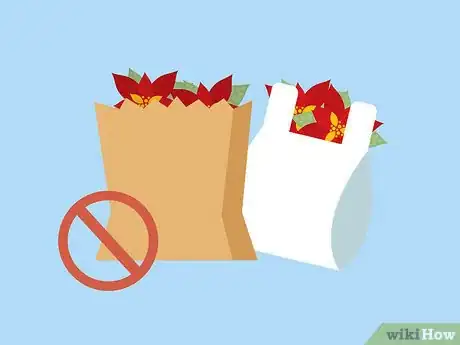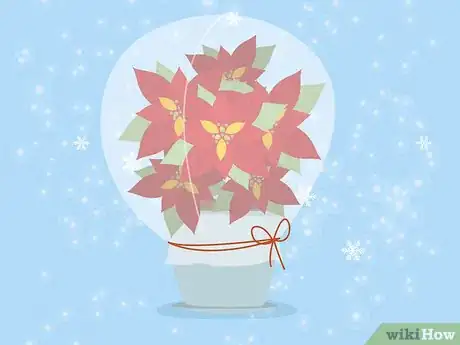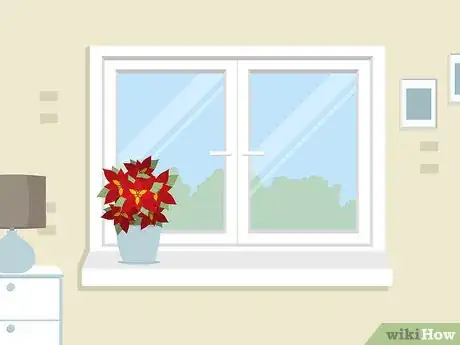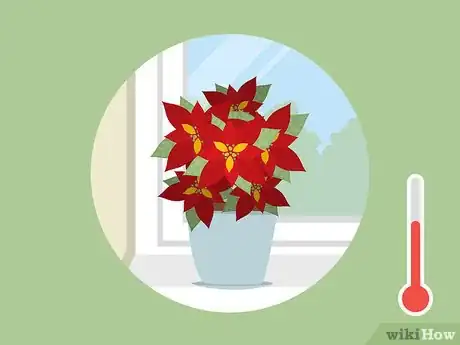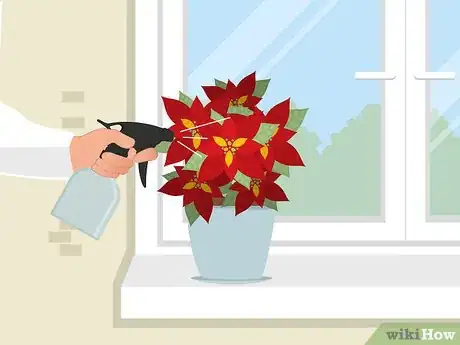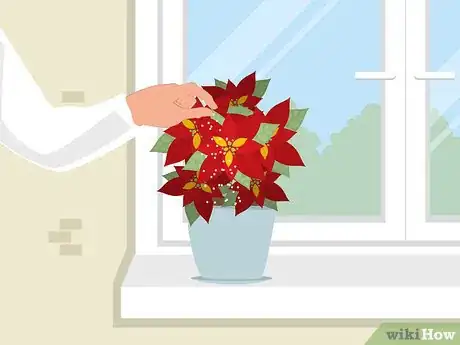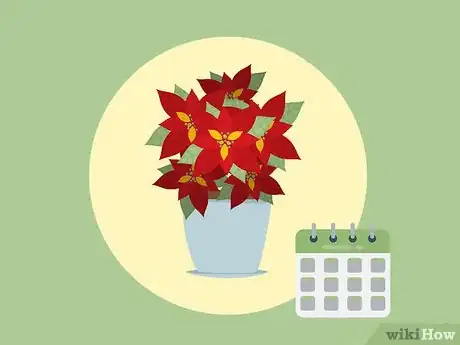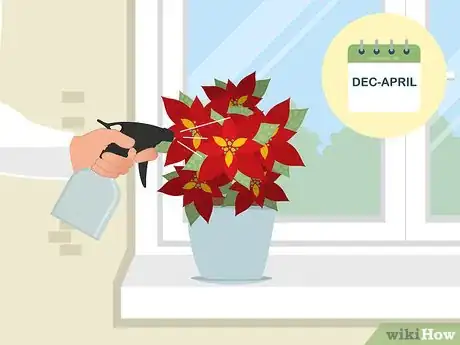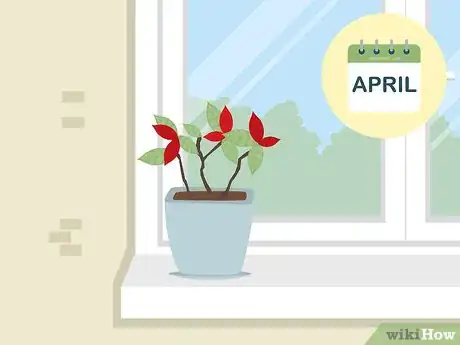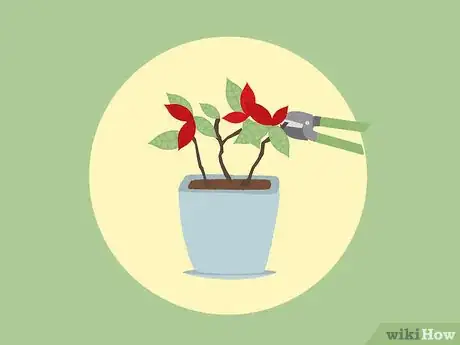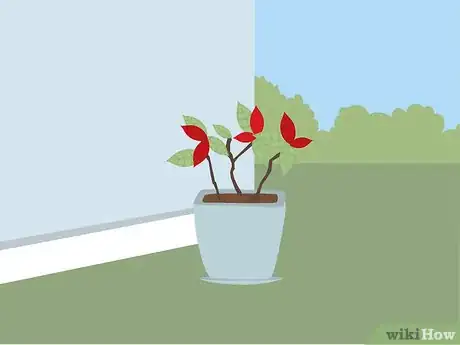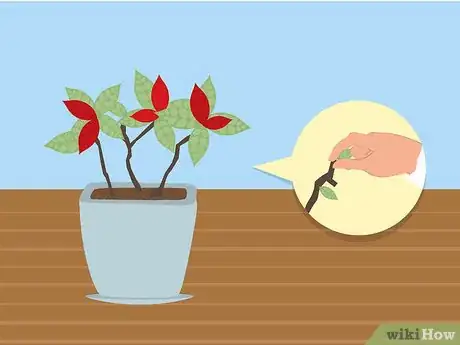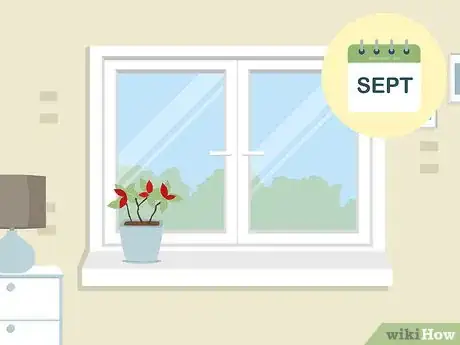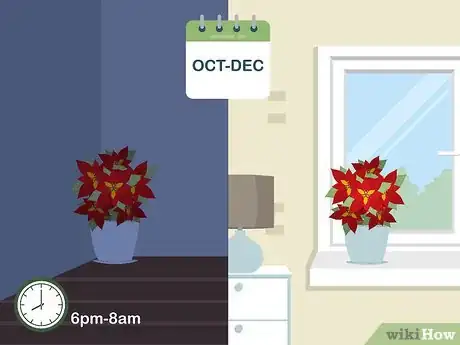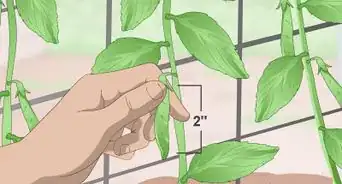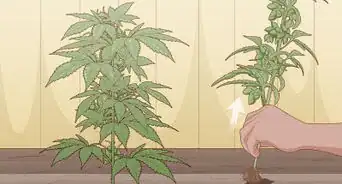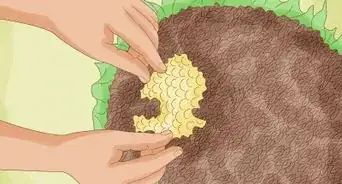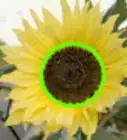This article was co-authored by Lauren Kurtz. Lauren Kurtz is a Naturalist and Horticultural Specialist. Lauren has worked for Aurora, Colorado managing the Water-Wise Garden at Aurora Municipal Center for the Water Conservation Department. She earned a BA in Environmental and Sustainability Studies from Western Michigan University in 2014.
wikiHow marks an article as reader-approved once it receives enough positive feedback. In this case, 91% of readers who voted found the article helpful, earning it our reader-approved status.
This article has been viewed 181,994 times.
The Aztecs in Mexico grew poinsettias, long before the first Europeans settled in the U.S. It wasn't until 1825 that the first U.S. ambassador to Mexico, Joel Roberts Poinsett, introduced the poinsettia to the U.S. Since then it has become ubiquitous as a Christmas plant. Caring for your poinsettia during the holidays season is easy, as they require little attention while in bloom. However, caring for your poinsettia throughout the year and getting it to rebloom the following December is another story. Here's how to do both.
Steps
Choosing Your Poinsettia
-
1Choose a healthy-looking plant. Healthy poinsettias should have dark green foliage and brightly colored bracts (these are the modified red leaves which look like petals). There should be no signs of wilting or drooping and no fallen or yellowed leaves.
-
2Observe the display conditions. The plant should look full and attractive and should not be crowded between other plants, as this can cause premature bract loss. It should stand two and a half times as tall as the diameter of its pot.Advertisement
-
3Check the leaves and soil. Check the soil for dampness: if it is very wet, but the plant looks wilted, this could be an indication of root rot. Then have a look at the underside of the leaves to check for insects such as aphids and whiteflies. Do not choose a plant whose leaves are spotted and yellow.[1]
-
4Examine the true flowers. The true flowers of the poinsettia plant can be found at the base of the red colored leaves, or bracts. They should look like small, fresh buds with red or green tips. If there is a layer of yellow pollen covering the flowers, this means that the plant is more mature and will not last as long.[2]
-
5Avoid buying poinsettias which are wrapped in paper or plastic. It is possible that the plant may have been displayed this way for some time. If this is the case, the leaves may turn yellow and fall off much sooner than expected.
-
6Be careful when bringing the plant home. It is important that you cover or sleeve the poinsettia before you take it home, if outside temperatures are lower than 50 °F (10 °C).
- If poinsettias are exposed to low outside temperatures for even a few minutes they can chill or even freeze, causing the leaves to droop and fall off.
- The gardening center or store where you purchase your poinsettia should be able to provide you with some form of protective covering for your trip home.
- Just make sure to remove the protective covering as soon as you get home, otherwise it could cause damage.[3]
Caring For Your Poinsettia
-
1Select a suitable location for the poinsettia. Place the poinsettia plant in a location where it receives at least six hours of indirect sunlight each day.
- Placing it near a sunny east or west facing window is ideal.
- Just don't let the leaves of the plant touch any cold window panes as this can cause them to freeze and fall off.[4]
-
2Maintain the correct temperature. Ideal temperatures for poinsettias don't reach above 70 °F (21 °C) during daytime hours or dip below 65 degrees at night.
- This is important in order to maintain the bright red color of the bracts.
- You should also avoid exposing the poinsettia to cold drafts, or to dry heat from radiators, appliances or open fires.
- Be aware that temperatures below 50 degrees will chill the plant and cause severe damage, while exposure to frost will kill it.
-
3Water the poinsettia when necessary. Poinsettias like moist but not soggy soil, so you should water your poinsettia when the surface of the soil feels dry to the touch. Water the plant until you see water begin to seep through the holes at the bottom of the pot.
- After 10 minutes, remove any excess water from the saucer beneath the pot. If the plant is left sitting in water, the soil will become too wet and will not contain enough air, leading to root rot and other diseases.
- If the plant is left too long without water, the leaves will begin to droop and wilt. To prevent this, make sure that you check the soil regularly. If the leaves do begin to wilt, water the plant at once, then water it a second time five minutes later.
-
4Fertilize your poinsettia after the holidays. Depending on when you purchased your poinsettia plant, it should not be necessary to fertilize it at any point before the holidays, while they are still blooming. You can usually wait until you've had the plant for about 6 to 8 weeks before it becomes necessary to fertilize.
- Of course, if you don't plan on keeping the poinsettia there will be no need to fertilize. Many people find that it's easier to just buy a new plant each year, rather than caring for the same one all year round.
- However if you do plan on keeping your poinsettia, you should use an all-purpose, water soluble houseplant fertilizer to fertilize the plant in early January. Use according to the manufacturer's instructions.
- The fertilizer will held to maintain the plant's green foliage and promote new growth.
Reflowering Your Poinsettia
-
1Commit to caring for your poinsettia. It is possible to hold on to your poinsettia plant and get it to bloom again the following year. However, this will require a yearlong schedule of care which must be strictly observed, otherwise the plant will fail to reflower.
-
2Maintain the same watering schedule til April. After the holidays, you can maintain the same watering schedule as before: watering the plant when the soil feels dry to the touch. Continue to fertilize the poinsettia every 6 to 8 weeks using an all-purpose houseplant fertilizer.
-
3Allow the plant to dry out. Once April comes, you should stop watering the poinsettia and allow it to gradually dry out. However, you should not allow it to get so dry that the stems begin to shrivel. During this time, store the plant somewhere cool and airy, at a temperature of about 60 °F (16 °C).
-
4Cut back the stems. At the end of spring, when the bracts turn a muddy green color, it is time to cut back the stems. Cut them to a length of about 6–8 inches (15.2–20.3 cm), though this will vary slightly with the size and shape of the plant. You can begin watering the plant again at this point, using the same procedures as before.
-
5Repot the plant if necessary. If the plant seems to be a bit cramped in its current pot, move it to a new one that's around 2 to 4 inches (5.1 to 10.2 cm) bigger. Use a commercial potting soil with a high percentage of peat moss. [5]
-
6Move the poinsettia outdoors. During the summer months, you can move the poinsettia outdoors (still in its pot). Place it in a lightly shaded area. Continue to regularly water and fertilize the plant.
-
7In August, prune the new shoots. Once August comes you can cut or pinch back the new shoots by about an inch, leaving three or four leaves on each. Fertilize again.
-
8Move the poinsettia back indoors. At the beginning of September (or well before the first frost) move the poinsettia back indoors. Place it near a window where it receives plenty of indirect natural light. Continue to water as before, and fertilize every two weeks.
-
9Follow the correct reflowering procedures. The poinsettia is a photoperiod plants, which means that its budding and flowering schedule is determined by the amount of daylight it receives. So in order to have the plant blooming at Christmas time, you will need to limit its exposure to light in the months running up to the holidays.
- From the 1st of October onwards, keep the poinsettia in complete, uninterrupted darkness for 14 hours a night, from 6 p.m. to 8 a.m. Move the plant to a dark room or cover the plant with a box. Be aware that even exposing the plant to artificial lighting can halt or delay the reflowering process.
- Remove the plant from the darkness during the day, as it will still need about 6 to 8 hours of daylight. Try to maintain the temperature between 60 and 70 degrees F and continue to water and fertilize the plant as normal.
- Follow these procedures for approximately ten weeks until the poinsettia reflowers and the bright red color begins to show on the bracts. Move the poinsettia back to a sunlit area and follow the care procedures described in the previous section!
Expert Q&A
Did you know you can get premium answers for this article?
Unlock premium answers by supporting wikiHow
-
QuestionHow do I fertilize my poinsettias?
 Lauren KurtzLauren Kurtz is a Naturalist and Horticultural Specialist. Lauren has worked for Aurora, Colorado managing the Water-Wise Garden at Aurora Municipal Center for the Water Conservation Department. She earned a BA in Environmental and Sustainability Studies from Western Michigan University in 2014.
Lauren KurtzLauren Kurtz is a Naturalist and Horticultural Specialist. Lauren has worked for Aurora, Colorado managing the Water-Wise Garden at Aurora Municipal Center for the Water Conservation Department. She earned a BA in Environmental and Sustainability Studies from Western Michigan University in 2014.
Professional Gardener
-
QuestionWhat are the white round things on top of the soil on a white poinsettia?
 Lauren KurtzLauren Kurtz is a Naturalist and Horticultural Specialist. Lauren has worked for Aurora, Colorado managing the Water-Wise Garden at Aurora Municipal Center for the Water Conservation Department. She earned a BA in Environmental and Sustainability Studies from Western Michigan University in 2014.
Lauren KurtzLauren Kurtz is a Naturalist and Horticultural Specialist. Lauren has worked for Aurora, Colorado managing the Water-Wise Garden at Aurora Municipal Center for the Water Conservation Department. She earned a BA in Environmental and Sustainability Studies from Western Michigan University in 2014.
Professional Gardener These are probably particles belonging to the soil your poinsettia was planted in, called perlite. This naturally occurring material is commonly added to soil mixtures to provide proper drainage and water retention. Perlite is a lightweight volcanic rock-like material. If perlite is not the culprit, granular fertilizer or an insect problem could be the white ‘things’ you are seeing.
These are probably particles belonging to the soil your poinsettia was planted in, called perlite. This naturally occurring material is commonly added to soil mixtures to provide proper drainage and water retention. Perlite is a lightweight volcanic rock-like material. If perlite is not the culprit, granular fertilizer or an insect problem could be the white ‘things’ you are seeing. -
QuestionWhy are my poinsettia's bottom leaves yellow and dropping off?
 wikiHow Staff EditorThis answer was written by one of our trained team of researchers who validated it for accuracy and comprehensiveness.
wikiHow Staff EditorThis answer was written by one of our trained team of researchers who validated it for accuracy and comprehensiveness.
Staff Answer wikiHow Staff EditorStaff AnswerYellowing leaves on the poinsettia usually indicate that the plant is either being overwatered or underwatered. Given they're usually kept indoors, the culprit is more often than not too much water, out of over-attentiveness to the plant. Only water when the soil feels just moist to the touch, otherwise it may become waterlogged. There are other possible causes, such as a mineral deficiency, root rot or over-fertilizing, each of which would need to be assessed in turn if the issue is not about watering.
wikiHow Staff EditorStaff AnswerYellowing leaves on the poinsettia usually indicate that the plant is either being overwatered or underwatered. Given they're usually kept indoors, the culprit is more often than not too much water, out of over-attentiveness to the plant. Only water when the soil feels just moist to the touch, otherwise it may become waterlogged. There are other possible causes, such as a mineral deficiency, root rot or over-fertilizing, each of which would need to be assessed in turn if the issue is not about watering.
Warnings
- Watch your poinsettia for insects and disease. Inspect your poinsettia for common insects like poinsettia horn-worms, aphids, mealybugs, scales, white-flies, and spider mites.⧼thumbs_response⧽
- Poinsettias contain a white sap made of latex, which can irritate the skin of people allergic to latex.⧼thumbs_response⧽
- Pick off poinsettia horn-worms with your fingers and destroy them. Wash the foliage with a gentle soap and water or wipe with rubbing alcohol to control other insects. For serious infestations, chemical control may be needed.⧼thumbs_response⧽
- Watch for fungal diseases like poinsettia scab, which is identified by circular white, yellow or brown spots on the leaves. The fungus can eventually take over the entire branch or plant if left uncontrolled. Remove affected areas immediately to avoid further contamination.⧼thumbs_response⧽
- Root rot is another fungal disease to look out for. Symptoms include the yellowing and dropping of the lower leaves. Unfortunately, by the time symptoms show up the disease is too far gone and the plant will not be salvageable.⧼thumbs_response⧽
References
About This Article
To care for a poinsettia, first, choose a spot where your poinsettia can get 6 hours of indirect sunlight each day. For example, set it near a sunny window facing east or west. Try to keep the temperature around 70°F (21°C), and make sure it never gets colder than 50°F (10°C) since it's leaves could fall off if it gets too cold. Poinsettias don’t need a lot of water, but you should water your plant when the soil feels dry. As you water the poinsettia, stop as soon as you see water leak through the holes at the bottom to the pot. This will prevent overwatering. Poinsettias only bloom from November to March, so most people prefer to buy a new one every year for the holidays. If you’d prefer to keep your poinsettia year round, fertilize it with an all-purpose fertilizer in early January. For tips on how to pick a healthy poinsettia from the store, keep reading!
